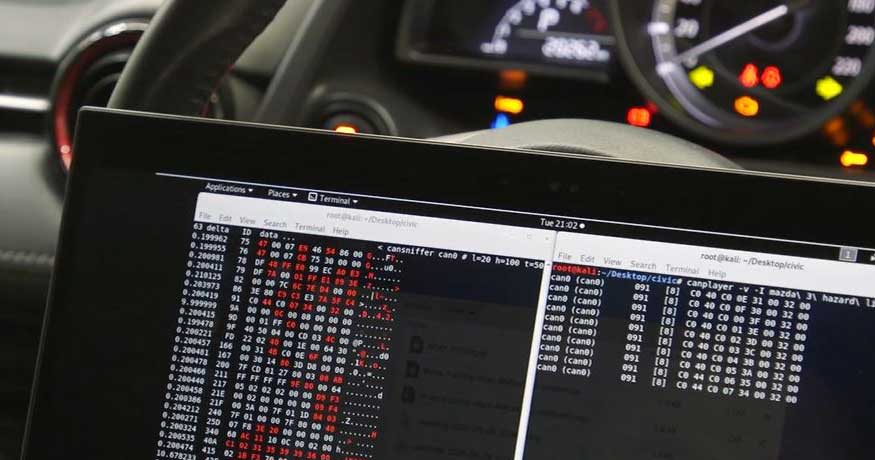
IAG student/industry project tackles vehicle cybersecurity issues

IAG has been a keen participant in the Undergraduate Student Industry Program since its inception over three years ago. This year, along with a band of students from UTS, it is taking on one of the smart mobility world’s biggest, most pressing issues – vehicle cybersecurity. Specifically, the group’s project investigated Vehicle Theft Resistance Testing of the CAN Bus Network.
The issue of cybersecurity in vehicles is a hot topic, and as we bound towards a more connected transport future this is also an area of great demand in terms of employment and implementation.
It is a topic that is high priority to many types of organisations, not least the ones which insure our vehicles. As a forward thinker in what changes in technology mean for our future insurance landscape, IAG has a Research Centre dedicated to learning more.
The adaptability displayed by the entire project team is a testament to their willingness to see the project through to completion.
Jacob Pace – Mobility Technology Research Consultant, IAG
It’s not the first time IAG hasve worked with a student research team through iMOVE, and it’s an association they continue to be pleased and impressed by.
‘We joined forces with another excellent group of students this year and were happy to see how quickly they grasped the opportunities and challenges facing vehicle security over the next decade and beyond,’ said IAG Mobile Technology Research Consultant Jacob Pace.

CAN Bus weakness? Can fix.
The CAN Bus system – responsible for controlling and communicating information around a vehicle – represents a potential point of malicious attack of automated vehicles. With this in mind, the challenge facing UTS students Jiang Bowen, Khalaf Alghamdi, and Xiaojie Lin, and supervisor Dr Xu Wang, was to create an assessment framework for the cybersecurity of vehicles.
CAN Bus connects many systems and sensors in vehicles, enabling communication between them all, and is the most widely used protocol for this purpose in automotive engineering. If there are flaws and weaknesses in the CAN Bus System, it could open the vehicle up to threats such as:
- Theft
- Fraud
- Unauthorised access to, or use or manipulation of, sensitive or personal data
- Remote control of vehicles and unauthorised access to subsystems
- Inability to hook into V2X: that is, allow communications with road signs, traffic lights, pedestrians, other vehicles, traffic management systems, networks, etc.
- Penetration and manipulation of over-the-air updates
Covering for COVID
In addition to this challenging work, the students were faced with the unanticipated additional challenge of learning during COVID. The pandemic forced a rethink on how to approach their project work.
‘In our original plan, students would go to the IAG Research Centre once per week. However, due to the pandemic that avenue was closed to us. So we redesigned the program,’ explained Dr Wang.
‘Collaboration was via a weekly online catch-up, and a virtual testbed. The students worked on the virtual testbed, tasks such as vehicle CAN bus messages, scripts and message checksum, before the online catch-up. In that the students would remotely test their scripts on the vehicles located in IAG’s Research Centre using TeamViewer and Webex.’
A student’s view
The reorganisation of the project did nothing to dampen the students’ enthusiasm to get involved and learn.
‘For me, the whole project was enjoyable and exciting because vehicle security is an important and developing area. What I really enjoyed during this project is the idea of personally absorbing new knowledge each time we faced a problem as a team,’ said Khalaf Alghamdi.
He also acknowledged the importance of undertaking a project directly relating to industry priorities.
‘It allowed us to develop applied knowledge. This project really showed me, beyond my studies, the real work and investigation required. Working with IAG enabled me to work on actual vehicles to investigate and identify their vulnerabilities instead of doing the work on simulations.’
What happens next?
The experience is already delivering positive outcomes for the students’ careers., The skills the students have learnt in this project will be put to good use post-graduation. One will carry on study and research on vehicle security, while another student has already started a job in a vehicle research centre.
And the future of collaboration between IAG and UTS?
‘This has been a wonderful opportunity, and we are discussing further collaboration after this project,’ said Dr Wang.
See the work and team in action
Here’s a short video presentation from the IAG and UTS teams, and their work on this vehicle cybersecurity project.
Discover more from iMOVE Australia Cooperative Research Centre | Transport R&D
Subscribe to get the latest posts sent to your email.




